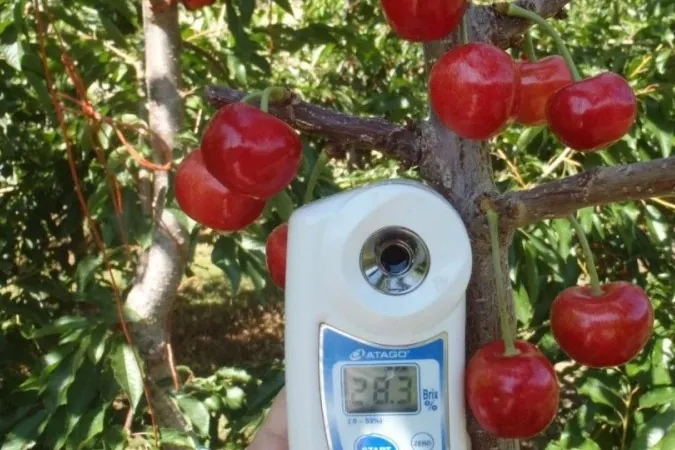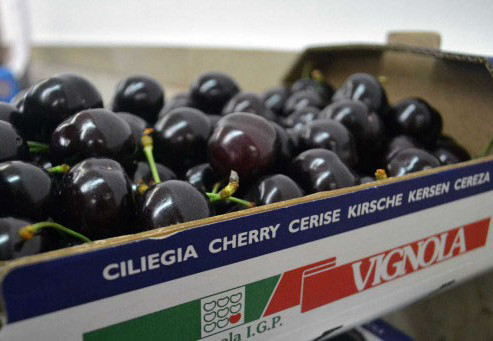Vigor control in high-density cherry orchards is a critical factor for maintaining a balance between fruit set, fruit size and overall fruit quality.
In the new plantings of the bicolour cultivar ‘Tip Top’ in Piedmont (northwest Italy), this balance is challenged by very vigorous vegetative growth and increasingly rainy, irregular springs.
The study by Varaldo and Giacalone (2025) investigates whether the preharvest application of prohexadione-calcium (Pro-Ca) on ‘Tip Top’ grafted onto Gisela 6 and MaxMa 14 can reduce vegetative vigor.
It also examines whether it is possible to improve fruit set, yield and the mechanical properties of the fruit epidermis.

A context of intensification
Over the past decade, sweet cherry cultivation has expanded rapidly across the plains of Piedmont, replacing less profitable crops such as peach and species affected by serious phytosanitary problems, such as kiwifruit.
The new orchards are established at high density, with dwarfing or semi-dwarfing rootstocks and covered with rain- and hail-protection nets.
This system offers protection against heavy rainfall, hailstorms and spring frosts, but it may reduce fruit firmness and cuticle resistance if vegetative vigor is not adequately controlled.
The bicolour cultivar ‘Tip Top’ fits well into this scenario thanks to its high sugar content and very attractive appearance, but it exhibits vigorous growth that can reduce fruit set and lead to insufficient epidermal coloration.
In this context, the use of growth regulators is considered a potential tool to modulate vigor; among them, prohexadione-calcium stands out for its rapid assimilation and its ability to inhibit gibberellin biosynthesis, reducing shoot elongation.
Experimental design and methodology
The study was conducted in 2025 in two commercial ‘Tip Top’ orchards located in Dronero (Piedmont), with trees grafted onto Gisela 6 (G6) and MaxMa 14 (M14), both grown under protective covers.
The experimental design included six randomized blocks for each orchard, five trees per block and four rootstock–treatment combinations: G6 control, G6 + Pro-Ca, M14 control, M14 + Pro-Ca.
Prohexadione-calcium was applied as the commercial formulation REGALIS®, with two foliar treatments (petal fall and fruit set), at a rate of 1.5 L/ha.
Harvest took place in June, once commercial maturity was reached, defined as soluble solids >18 °Brix for untreated ‘Tip Top’ on Gisela 6.
Measurements included fruit set, vigor (shoot elongation), total yield and non-marketable yield.
Distribution of fruit sizes, epidermal colour, mechanical properties (puncture test for epidermis; compression test for flesh) and chemical parameters (soluble solids, titratable acidity, total phenolics and antioxidant capacity) were also evaluated.
Results: fruit set and yield
Regarding fruit set, the effect of Pro-Ca was evident and rootstock-dependent.
The treatment increased fruit set by about 10 percent compared to controls, but this increase was concentrated in the ‘Tip Top’/Gisela 6 combination, which showed significantly higher values than the other treatments.
No significant differences were observed on MaxMa 14 between treated and untreated trees.
The same pattern was observed for vigor and yield.
G6 control and M14 control showed greater shoot elongation than treated trees, but only on Gisela 6 was the reduction in vigor clearly significant.
Four months after treatment, G6 + Pro-Ca trees showed an average shoot length of about 33 cm, the lowest among all treatments.
As for yield, Gisela 6 with Pro-Ca achieved the highest production, with 6.7 kg of marketable fruit per tree, significantly surpassing all other combinations.
Defects, fruit size and epidermis
Rootstock also influenced the proportion of non-marketable fruit: Gisela 6 showed the lowest percentages, below 2.5 percent, with no differences between control and Pro-Ca.
MaxMa 14, on the other hand, showed a significantly higher share of defects, especially in the Pro-Ca treatment.
Regarding fruit size, most fruit fell into the 30 mm class, with a higher proportion of fruit >30 mm in treated trees on both Gisela 6 and MaxMa 14, at the expense of the 28 mm class.
The percentage of fruit <26 mm was very low in all combinations and considered marginal.
Mechanical properties confirmed that Pro-Ca’s main effect focuses on the epidermis.
The puncture test (epidermal breaking force) was highest in G6 + Pro-Ca fruit, which showed the firmest and thickest epidermis in the experiment.
In both rootstocks, treated fruit displayed higher PT values compared to controls, whereas the compression test, related to flesh firmness, showed no significant differences.
Colour, chemistry and implications
The authors conclude that Pro-Ca primarily modifies the mechanical properties of the epidermis, rather than flesh firmness.
Regarding coloration, prohexadione-calcium increased the extension of the red overcolour on the epidermis in both rootstocks, with G6 + Pro-Ca and M14 + Pro-Ca showing higher percentages of red surface compared to controls.
Colorimetric parameters indicated a more intense red hue and lower lightness in treated fruit, consistent with deeper pigmentation.
Chemically, fruit from trees treated with Pro-Ca displayed higher soluble solids, lower titratable acidity and therefore a more favourable sugar/acid ratio.
Moreover, both total phenolic content and antioxidant capacity were markedly higher in G6 + Pro-Ca and M14 + Pro-Ca, with no relevant differences among controls.
Overall, the results show that Pro-Ca can be a useful tool for modulating the vegetative–reproductive balance of ‘Tip Top’ in high-density systems, particularly in combination with Gisela 6.
This combination simultaneously ensures reduced vigor, higher fruit set and yield per tree, and fruit with a firmer, better-coloured and phenolic-rich epidermis with greater antioxidant capacity.
The authors note that this strategy may reduce the need for intensive agronomic interventions (summer pruning, severe winter pruning) and improve orchard production efficiency, always with applications calibrated to the rootstock and local conditions.
Source: Varaldo, A.; Giacalone, G. (2025). Preharvest Prohexadione-Ca Treatment Improves Fruit Set and Mechanical Properties in Cv. ‘Tip Top’ Sweet Cherries. Agronomy 15: 2596. https://doi.org/10.3390/agronomy15112596
Image source: ANA Chile
Jesus Alonso
El mundo de las cerezas
Cherry Times – All rights reserved













